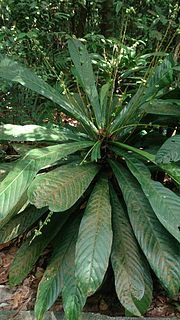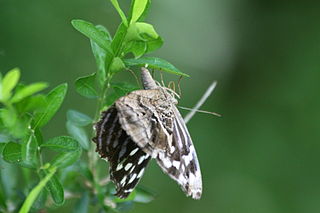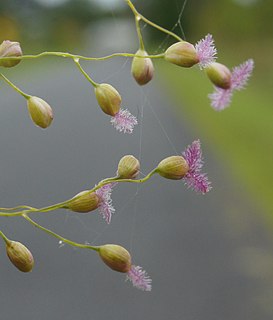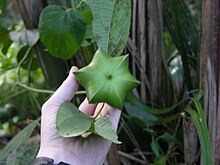
Phyllanthus is the largest genus in the flowering plant family Phyllanthaceae. Estimates of the number of species in this genus vary widely, from 750 to 1200. Phyllanthus has a remarkable diversity of growth forms including annual and perennial herbs, shrubs, climbers, floating aquatics, and pachycaulous succulents. Some have flattened leaflike stems called cladodes. It has a wide variety of floral morphologies and chromosome numbers and has one of the widest range of pollen types of any seed plant genus.

Phyllanthaceae is a family of flowering plants in the eudicot order Malpighiales. It is most closely related to the family Picrodendraceae.

The family Pandaceae consists of three genera that were formerly recognized in the Euphorbiaceae. Those are:

The Pooideae are the largest subfamily of the grass family Poaceae, with about 4,000 species in 15 tribes and roughly 200 genera. They include some major cereals such as wheat, barley, oat, rye and many lawn and pasture grasses. They are often referred to as cool-season grasses, because they are distributed in temperate climates. All of them use the C3 photosynthetic pathway.

The Acalyphoideae are a subfamily within the family Euphorbiaceae with 116 genera in 20 tribes.

The Acalypheae is a tribe of the subfamily Acalyphoideae, under the family Euphorbiaceae. It comprises 12 subtribes and 32 genera.

The Agrostistachydeae is a tribe of the subfamily Acalyphoideae, under the family Euphorbiaceae. It comprises 4 genera, which are monophyletic.

Alchorneae is a tribe of plants in the subfamily Acalyphoideae, under the family Euphorbiaceae. It comprises 2 subtribes and 7 genera.
The Ampereae is a tribe of the subfamily Acalyphoideae, under the family Euphorbiaceae. It comprises 2 genera.
Galearieae is a no-longer-recognized tribe of plant of the family Euphorbiaceae. It comprised 3 genera, Galearia, Microdesmis, and Panda. Molecular data show that although these three genera are related to each other, they do not belong in the subfamily Acalyphoideae of the Euphorbiaceae, and therefore they are generally now classified as the family Pandaceae.

Adelia is a genus of flowering plants in the spurge family, Euphorbiaceae, subfamily Acalyphoideae. It is native to Latin America and the Caribbean, with one species extending northward into the southernmost part of Texas.

Glochidion is a genus of flowering plants, of the family Phyllanthaceae, known as cheese trees or buttonwood in Australia, and leafflower trees in the scientific literature. It comprises about 300 species, distributed from Madagascar to the Pacific Islands. Glochidion species are used as food plants by the larvae of some Lepidoptera species including Aenetus eximia and Endoclita damor. The Nicobarese people have attested to the medicinal properties found in G. calocarpum, saying that its bark and seed are most effective in curing abdominal disorders associated with amoebiasis.

The Euphorbiaceae are a large family, the spurge family, of flowering plants. In common English, they are sometimes called euphorbias, which is also the name of a genus in the family. Most spurges such as Euphorbia paralias are herbs, but some, especially in the tropics, are shrubs or trees, such as Hevea brasiliensis. Some, such as Euphorbia canariensis, are succulent and resemble cacti because of convergent evolution. This family occurs mainly in the tropics, with the majority of the species in the Indo-Malayan region and tropical America a strong second. A large variety occurs in tropical Africa, but they are not as abundant or varied as in the two other tropical regions. However, the Euphorbiaceae also have many species in nontropical areas such as the Mediterranean Basin, the Middle East, South Africa, and the Southern United States.

The Stipeae are a tribe of grasses within the subfamily Pooidae, with up to 600 described species.
Bia is a genus of plant of the family Euphorbiaceae first described as a genus in 1841. The entire genus is native to South America.
- Bia alienataDidr. - Brazil, Bolivia, Paraguay, N Argentina
- Bia capivarensisMedeiros & Alves - Serra da Capivara
- Bia fallax(Müll.Arg.) G.L.Webster - Peru, Rondônia
- Bia fendleri(Müll.Arg.) G.L.Webster - Guyana, Venezuela, Amazonas State of Brazil
- Bia lessertianaBaill. - Fr Guiana, Suriname, Guyana, N Brazil
- Bia manueliiV.W. Steinm. & Ram.-Amezcua, 2013, Sierra de Coalcomán, Michoacán, Mexico

Micrairoideae is a subfamily of the grass family Poaceae, distributed in tropical and subtropical regions. Within the PACMAD clade, it is sister to subfamily Arundinoideae.
Plukenetia conophora, also called Nigerian walnut, and conophor, is a climbing shrub in the genus Plukenetia. It is not related to the walnut, being so named because its nuts bear a superficial resemblance to the walnut. It is native to tropical western and central Africa from Togo to Congo and in Sierra Leone. It is abundant in the Nigeria, Cameroon, Republic of the Congo and Democratic Republic of Congo. It prefers rain-forest hedge in half-shady places; low bush; secondary forest; plantations at elevations from 250–1,400 m (820–4,590 ft). Although it is well recorded in Sierra Leone, it is apparently not indigenous to Sierra Leone, since it is not recorded in Liberia and Ghana. Its presence in Sierra Leone is due to returning slaves for it is known to the Krio by its Yoruba (Nigerian) name. Plukenetia conophora is the only Plukenetia species native to West Africa or Central Africa. Other Plukenetia species are indigenous to other parts of Africa, the Indian Subcontinent, Southeast Asia, and America.

Cynodonteae is a large tribe of grasses in the subfamily Chloridoideae, with over 800 species.

Paspaleae is a tribe of the Panicoideae subfamily in the grasses (Poaceae), native mainly to the tropical and subtropical Americas but with a number of species introduced to other regions. It includes roughly 680 species in 39 genera. Species in this tribe use either of the C3 or C4 photosynthetic pathways.















